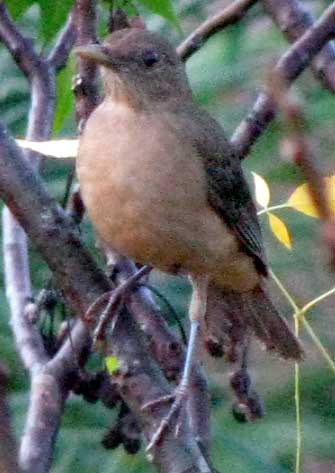Excerpts from Jim Conrad's
Naturalist Newsletter
from the May 12, 2007 Newsletter issued from Sierra Gorda Biosphere Reserve, QUERÉTARO, MÉXICO
CLAY-COLORED ROBINS BUILDING NESTS
One of my favorite hiking destinations lies at the far end of the reservoir, about 45 minutes away, where the valley narrows, the lake becomes a trickling stream, and Bonpland Willows and Mexican Sycamores create a shadowy woods. Livestock trails paralleling the stream take me through the woods. Beneath every big tree there's always a comfortably rounded boulder you can sit on, and always the birds are putting on a show.
This week Clay-colored Robins have been particularly vocal and busy. They hop on the ground tossing litter aside with their bills just like American Robins. When worried about something they issue nasal clucks the way nervous American Robins do, and their body shape and size is just like the American Robin's. The only obvious big difference between the two species is that the Clay-colored's drab plumage shows only hues of brown. Below, you can see one I photographed another time in the Yucatán.

If your computer can handle WAV files you can hear one by clicking on the "play" button on the blue thing here.
This week I watched a Clay-colored Robin starting the building of her nest with what appeared to be dried-up willow rootlets left hanging on dry banks, now that the water is so low. I read that the finished nest will have a middle layer of mud. The species lays 2-3 pale to bright blue eggs, and may produce two broods. I also read that Clay-colored Robins eat earthworms, slugs, insects, fruits, and sometimes lizards. They follow army ants and feed on small animals trying to escape the ant columns.
Clay-colored Robins are so reminiscent of American Robins that I just assumed that, as with the American Robin, the Clay-colored male would claim and vigorously defend a territory, while the female nested somewhere within it. Therefore, this week, what I saw didn't make sense.
Around the tree where the female Clay-colored Robin was building her nest I saw three other Clay-colors doing various things. Moreover, as I continued up the valley I passed through several clusters of the species. I heard lots of singing and saw some courtship behavior but most robins seemed to be doing nothing special. In fact, what stuck me was that nowhere could I see territory-boundary disputes taking place, and clearly there were no territories being claimed by exclusively male-female family units. This was a situation to place before Google.
On the Internet I found no comprehensive description of Clay-colored Robin behavior, but I did find brief references and side remarks that gradually presented a picture.
In an online article of the journal The Condor,at http://www.princeton.edu/~hau/ReprintLinks/2003Condor105.pdf I found the Clay-colored Robin's social system described as "mating aggregations, leks," and its territoriality as "short, local display court." In the same paper I read that Clay-colored Robins "display in groups."
That word "lek" refers to an aggregation of males, each seeking to attract a mate, and each displaying fervently. It's assumed that "lekking" groups attract more females than do isolated males, and probably this helps the females better compare their potential mate.
Another online article referred to Clay-colored Robins as "polygynous," and yet another called them a "potentially polygynous (lekking) species." In biology, polygyny is a mating practice in which the male takes more than one female sexual partner.
Digesting these laconic and somewhat cryptic lines gradually I conjured an idea of what I'd seen among the Clay-colored Robins that day.
I would guess that that morning the livestock trail along the stream took me through one "mating aggregation" after another, each group consisting of one to several females and a male, and maybe there were "surplus males" weaving in and out of groups as opportunities arose.
That's just a guess, though. The only thing for sure is that at first glance Clay-colored Robins may remind us a very great deal of American Robins, but by no means do their mating activities come close to how Northerners expect a good robin to behave.